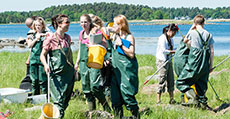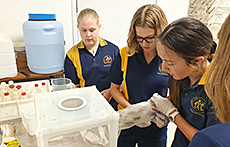Citizen science school teacher resources
Definition of citizen science
Citizen science allows volunteers to participate in research projects, with the aim to help scientists and community groups increase scientific knowledge.
Students can take part in fun, hands-on activities that can be tailored to suit your classroom. There are opportunities to learn about science, and take part in real-world science projects that can have a positive impact in local communities.
There are many different types of citizen science projects underway in Queensland, including topics involving ecology, biology, astronomy, biochemistry, health, social science and archaeology—to name just a few.
Students interact with researchers and scientist while doing the ‘job’ of a researcher while learning a range of scientific techniques.
The Australian Citizen Science Association defines citizen science as public participation and collaboration in scientific research with the aim to increase scientific knowledge.
To incorporate citizen science in the classroom, you can choose to join a citizen science project already underway and contribute to important research, or design your own project tailored to your school or your students’ interests.
You can review our searchable list of teacher resources and links.
Ten principles of citizen science
Read the Australian Citizen Science Association’s ten principles of citizen science to understand more about what citizen science is all about. You can download the principles.
Citizen science lends itself to building scientifically literate individuals
Engaging with a citizen science project can help students to:
- connect scientific knowledge to everyday life and the world around them
- understand uncertainty and risk
- be inspired about the work of scientists
- understand the impact of science on people’s lives
- identify scientific questions, investigate and draw evidence-based conclusions
- apply their knowledge in a broad range of relevant practical situations such as field work
- collaborate, work safely and effectively in teams
- become responsible citizens who are able to make informed decisions about the environment and their own health and wellbeing.
Curriculum connections
Science
- Take part in sampling, data collection and observing the environment
- Ask questions, make predictions and review evidence
- Identify species
- Use scientific equipment
- Communicate scientifically
- Undertake research and conduct experiments
- Understand how science is a human endeavour
Information and Communication Technology (ICT) and Literacy
- Use mobile devices and apps to collect data and make identifications
- Present findings, write research-based reports
Numeracy
- Use counting skills/tally marks and other recording methods
- Make predictions, consider inaccuracies and error
- Conduct statistical analyses
- Discuss probabilities
Humanities and Social Sciences
- Research environmental issues
- Discuss climate and weather and how they impact living things
- Use maps to interpret data
Community connections
- Work with local groups on local issues
- Cooperate with other schools or organisations in conducting research or holding a bioblitz
Getting started – join an existing project
The next steps to involve citizen science in your classroom:
- Find a project of interest that supports your class’s learning goals
- Search the Australian Citizen Science Project Finder to find projects based on location or topic AND/OR
- Search our project list AND/OR
- Search our list of resources for teachers
- Review the information from the citizen science groups for suitability and get started with your chosen project:
- Follow the steps listed on the project’s website (this may involve creating online accounts with apps such as iNaturalist or Questagame) to register with the project OR
- Make contact with the project leader to see how you could work together AND/OR
- Contact the Office of the Queensland Chief Scientist who can facilitate introductions to citizen science groups running projects in your area - you may like to invite the citizen science project leader to meet you and your class
- Begin contributing to science research
Getting started – start your own project, a bioblitz
Thank you NaturePlay Queensland for this section. The NaturePlay Queensland bioblitz uses the iNaturalist app.
A ‘BioBlitz’ is a concerted effort to discover and record as many living things as possible within a set location over a limited time period (usually 24 to 36 hours). The main scientific aim of a BioBlitz is to generate or extend biodiversity data at the chosen location. BioBlitzes cannot be complete biological surveys but they do create significant species lists and have facilitated the discovery of new species, the rediscovery of rare species and the identification of species where they are not usually found.
Resources and preparation
- Prepare login account for iNaturalist.
- Digital cameras / tablets for taking photo observations.
- Clipboards, pencils for taking notes on what has been observed, where and when.
- Rope to mark out the Blitz area for your student groups (1mx1m).
- Mark out the Blitz areas and consider how you will group your students.
- Optional tools to help eg. magnifying glasses.
- Consider inviting a local naturalist as a special expert guest for the activity.
Activity plan
- Head outside and model the activity at one assigned BioBlitz location.
- Break into smaller groups, each assigned a BioBlitz location (marked out using rope in a 1mx1m area – consider different locations around the school, could use skipping ropes to mark out).
- Enter the student’s observations in to the iNaturalist app or website (you may wish to wait until you return to the classroom to complete this step).
- At the end of the time, return for a class discussion.
Discussion questions
- What sorts of plants and animals did you find?
- What did you notice about your BioBlitz site?
- What could impact on the species that were living in the area?
- How many species did they estimate to have found?
- What could we do next with this data?
- What could a scientist do with this data?
- Would repeating this BioBlitz at a different time be useful? What might we discover?
Bioblitz lesson plans
- Pre-kindy and kindy lesson plans
- Prep and year 1 lesson plans
- Year 2 and year 3 lesson plans
- Year 4 and year 5 lesson plans
- Year 6 lesson plans
Teacher resources and links
Search the list of resources and links developed by citizen science groups. Some resources outline how to take part in a citizen science activity (such as observing species, collecting and recording litter or taking part in water quality monitoring), while other resources are to educate students about the focus of the project (such as the Great Barrier Reef or turtles or shore birds).
You can find more information about citizen science in Queensland.
Email the Office of the Queensland Chief Scientist if you’d like an introduction to scientists or community groups involved in citizen science at info@chiefscientist.qld.gov.au.
Citizen science projects and resources

For more ideas on how to incorporate citizen science in your classroom, read our list of citizen science projects and search the teacher resource list, which highlights lesson plans and teacher guides developed by citizen science groups.
Featured resource:
Wildlife Spotter on DigiVol
Help save threatened species and preserve Australia’s iconic wildlife. Become a citizen scientist and assist researchers by looking for animals in wilderness photos taken by…
Queensland case study

Download the Quick guide to citizen science with school students , which includes a snapshot of the Maggot Menageries project and some recommendations for researchers and teachers who want to begin a citizen science project.
Read further details in the Citizen Science: Theory and Practice article, Maggot Menageries: High School Student Contributions to Medicinal Maggot Production in Compromised Healthcare Settings.